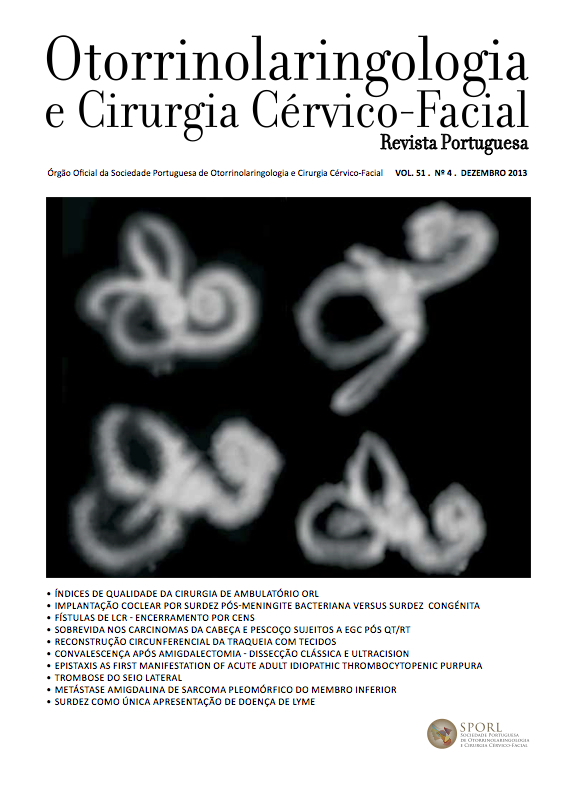Sudden Deafness: What are we missing? Deafness as a Lyme´s disease single presentation
DOI:
https://doi.org/10.34631/sporl.53Keywords:
sudden deafness, Lyme´s diseaseAbstract
Introduction: Lyme´s disease is a systemic infection and the most common thick-borne disease in North America, Europe and Asia. Described for the first time in 1977 in the US and in 1989 in Portugal, it became a notifiable disease in 1999. Lisbon district is the most affected area, with an annual incidence of 0,04/100000 habitants.
Objective: To present the clinical case of a female patient with unilateral sudden deafness as the single Lyme´s disease manifestation.
Material and methods: A 40 yo female patient complaining of a right sudden deafness with 48h of evolution. All anamnesis evaluation was normal. She has been medicated immediately with steroids, antiretrovirals and hyperbaric oxygen and a laboratorial and imagiological investigation began.
Results: Partial recovery was noticed after 10 hyperbaric therapeutic sessions. Laboratory evaluation confirmed Borrelia Burgdorferi IgM antibodies and the MRI scan showed a right labyrinthitis. She started doxycycline and she totally recovered from deafness. Borrelia serology became negative and the imagiological signs of labyrinthitis were absent 5 months after the diagnosis.
Conclusion: Sudden deafness can be the only Lyme´s disease manifestation, despite being usually a systemic disease. Specific diagnosis and therapy avoided some of the serious complications of the disease, neurological for instance. Therefore it is important to go through detailed diagnostic tests in sudden deafness cases, in order to diagnose and treat possible curable causes.
Downloads
References
Centers for Disease Control and Prevention, Division of Vector-Borne Infectious Diseases. Lyme disease statistics: 2009. Available at http://www.cdc.gov/ncidod/dvbid/lyme/ld_statistics.htm.
Rizzoli A, Hauffe HC, Carpi G, Vourch´h GI, et al. Lyme Borreliosis in EuropE. Euro Surveill. 2011;16(27):pii=19906. www.eurosurveillance.org/ViewArticle.aspx?Articleld=19906. Acedido em Fevereiro 2, 2012.
Hubálek Z. Epidemiology of Lyme borreliosis. Curr Probl Dermatol. 2009;37:31-50.
Rauter C, Hartung T. Prevalence of Borrelia burgdoferi sensu lato genospecies in lxodes ricinus ticks in Europe: a metaanalysis. Appl Environ Microbiol. 2005;71(11):7203-16.
David de Morais JA, Filipe AR, Núncio MS. Doença de Lyme em Portugal. Caso Clínico. Rev Port Doenç Infec. 1989;12:261-76.
Lopes de Carvalho I, Núncio MS. Laboratory daignosis of Lyme borreliosis at the Portugueze National Institute of Health (1990-2004). Euro Surveill. 2006;11(10):pii=650. www.eurosurveillance.org/ViewArticle.aspx?Articleld=650.
Fetterman BL, Saunders JE, Luxford WM. Prognosis and treatment of sudden sensorineural hearing loss. The American journal of otology. 1996, Vol. 17, pp. 529-36.
Mosnier I, Bouccara D, Sterkers O.Les surdités brusques en 1997: hypothèses étiopathogéniques, conduite à tenir, facteurs
pronostiques, traitements. Ann Otolaryngol Chir Cervicofac 1997;114:251-66
Byl FM Jr. Sudden hearing loss: eight years’ experience and suggested prognostic table. Laryngoscope. 1984;94:647-61.
Chau JK, Lin JR, Atashband S, Irvine RA, Westerberg BD. Systematic review of the evidence for the etiology of adult sudden sensorineural hearing loss. Laringoscope 2010;120:1011-21
Merchant SN, Adams JC, Nadol JB. Pathology and pathophysiology of idiopathic sudden sensorineural hearing loss. Otol Neurotol. 2005;26:151-60.
Hoen AG, Margos G, Bent Sj, Diuk-Wasser MA, et al. Phylogeography of Borrelia burgdoferi in the eastern United States
reflects multiple independente emergence events. Proc Natl Acad Sci USA. 2009;106(35):15013-8.
Stanek G, Reiter M. The expanding Lyme Borrelia complexclinical significance of genomic species? Clin Microbiol
Infect.2011;17(4):487-93.
British Infection Association. The epidemiology, prevention, investigation and treatment of Lyme borreliosis in United Kingdom patients: A position statement by the British Infection Association. J Infect. 2011;62(5):329-38.
Stanek G, Wormser GP, Gray J, Strle F. Lyme borreliosis. Lancet 2012;379:461-73.
Rudenko N, Golovchenko M, Grubhoffer L, Oliver JH Jr. Thicks Tick Borne Dis 2011;2(3):123-8.
Ertel SH, Nelson RS, Cartter ML. Effect of surveillance method on reported characteristics of Lyme Disease , Connecticut, 1996-2007. Emerg Infect Dis 2012; 18(2): 242-7.
Girschick HJ, Morbach H, Tappe D. Treatment of lyme borreliosis. Arthritis Res Ther 2009;11(6):258.
Coumou J, Van der Poll T, Speelman P, Hovius JW. Tired of Lyme borreliosis. Lyme borreliosis in the Netherlands. Neth J Med. 2011; 69:101-11. Review.
Peltomaa M, Pyykkö I, Sappälä I, Viitanen L, Viljanen M. Lyme borreliosis, an etiological factor in sensorineural hearing loss? Eur Arch Otorhinolaryngol. 2000;257:317-22.
Girschick HJ, Morbach H, Tappe D. Treatmente of Lyme borreliosis. Arthritis Res Ther. 2009;11:258
Logigian EL, Kaplan RF, Steere AC. Chronic neurologic manifestations of Lyme disease. N Engl J Med. 1990;323:1438-44






